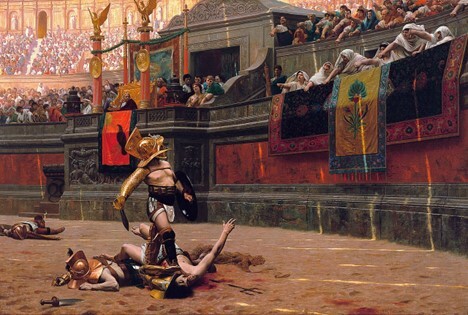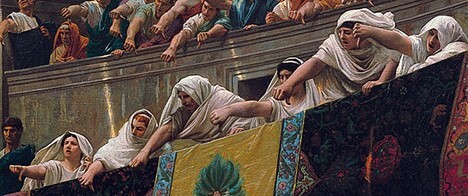Thumbs Up
Recently I received an alumnae magazine from my old high school. The cover photo featured a young woman in her graduation cap and gown. She sported a big smile and gave the viewer two thumbs up, which struck me as odd. Perhaps it’s because I associate the grin and thumbs up with older (mostly male) politicians. Some use the gesture so often it becomes a sort of trademark image. It might be accompanied by a wink, a grin, or an outstretched pointer finger in the other hand. It’s a practiced pose.





According to some sources, the thumbs-up gesture became popular during World War II among fighter pilots who used the sign to indicate from the cockpit that they were ready for take-off. It was easy to see and understand from the ground. It also carried some of the cool bravado of the fighter pilot. So it soon spread.
Maybe it’s this sense of warrior cool that the politicians are trying to convey.
Gladiators


An even earlier origin story is from the Roman Empire’s gladiator battles. If you saw Russell Crowe as Maximus in Gladiator, you know the dramatic scene in which Emperor Commodus holds his thumb out sideways and then turns it down, indicating that Maximus should kill his opponent. Maximus instead spares the man’s life, infuriating the Emperor.
That gesture, the thumbs down, appears in the movie because of a famous 1872 painting by Jean-Leon Gerome entitled “Pollice Verso,” The Turned Thumb. (Painting and detail from it pictured above.) In it a rabid crowd in the Roman Coliseum calls for the death of a combatant by giving the thumbs down signal. Ridley Scott, the director of Gladiator, said, ”That image spoke to me of the Roman Empire in all its glory and wickedness. I knew right then and there I was hooked.” However, the painter might have gotten his facts confused. In some cases, the gesture used to spare a life was the thumb pressed into the inside of the fist, perhaps like the sword being returned to its sheath. Ultimately, it doesn’t matter. The gesture has gone down in popular belief as thumbs up = life while thumbs down = death.
Happy Days

Fonzie, played by Henry Winkler, helped bring back the thumbs up gesture in Happy Days, the TV sitcom set in the somewhat idyllic 1950’s of Middle America, which aired from 1974 to 1984. When Fonzie gave the thumbs up, it meant cool, young, and hip, self-assured and likeable. Not exactly fighter pilot or gladiator. Definitely more fun. Again, though, it is exclusively male. It goes with Fonzie’s Triumph motorcycle, leather jacket, and slicked-back hair.
Two Thumbs Up
Over the same time period, Gene Siskel and Roger Ebert, two movie critics in Chicago, put together several television series using the signs “Thumbs up” or “Thumbs down” to describe their views of current films. If one reviewer was particularly enthusiastic about a movie, he would give it “two big thumbs up.” On the other hand, they didn’t hesitate to call out what they saw as a bad film by giving it a “thumbs down” or even a skunk, for the Stinker of the Week award.
The thumbs up/down signal in these shows meant general approval or disapproval rather than anything associated specifically with males or warriors or even coolness.

The real popularization of the thumbs-up sign came with the rise of Facebook, which introduced the thumb-up sign in 2009 to mean “like” – a broad term that encompasses agreement, approval, appreciation, or simply acknowledgement. During initial discussion, the feature was referred to as “awesome” and was marked by a star or a plus sign. However, it was the thumbs up sign that was officially adopted and has since became synonymous with Facebook.
But problems arose, right from the start. Users complained that the Like/thumbs up response was too vague. Does it mean “I agree!” “OK,” “Got it,” “Whatever,” “Thanks for posting this. It made my day,” “I read your post,” or “ Amazing”? If your friend posted something about the death of their dog, would you respond with a thumbs-up?
In response to user demand, Facebook added new emoji response options in 2015: “Love,” Haha,” “Wow,” ”Sad,” and “Angry.” “Yay” was considered but never adopted. In 2020, Facebook added the “care” emoji, with the face hugging a heart. Despite many requests for a “Dislike” button, it was never added.

Other problems with the thumbs-up image necessitated a more massive change. It’s considered a vulgar gesture in many cultures. Think middle finger raised. A sexual insult. It can also mean the number one (Germany and Hungary) or the number five (Japan), a directional symbol, the hitchhiking gesture, or other possibilities.
A scuba diving instructor told me that the thumbs-up sign underwater means you’re heading up toward the surface, not that you’re okay.
Given this potential for misunderstanding, in 2021, Facebook replaced both the name and the thumbs-up icon so synonymous with Facebook with a slightly droopy infinity loop, the logo of the newly branded Meta.
In the end, it may be so deeply rooted in our culture that it will continue with or without Facebook’s help. The image on the cover of the alumnae magazine that bothered me is a product of two different cultures clashing. While I see the gesture as a kind of male bragging, the woman in the photo, having grown up with the symbol on social media, probably sees it as a sign of celebration and success.
Sources and interesting reading:
Bryner, Jeanne, “Why the thumbs-up won’t go away,” NBC News, from Live Science, 23 May 2008, https://www.nbcnews.com/id/wbna24792764
Cunningham, Ryan, “The strange, brief history of Trump’s trademark thumbs up,” The Outline, 31 May 2018, https://theoutline.com/post/4748/trump-thumbs-up-sign
“Dispelling Some Myths: Thumbs Up,” Tastes of History, 21 June 2020, https://www.tastesofhistory.co.ik/post/dispelling-some-myths-thumbs-up
Fabry, Merrill, “Where Does the Thumbs-Up Gesture Really Come From?” History@Time.com, 25 October 2017, https://time.com/4984728/thumbs-up-thumbs-down-history/
“Like Button,” Wikipedia, https://en.wikipedia.org/wiki/Like_button#
“The Meaning and origin of the expression: Thumbs Up,” The Phrase Finder, https://www.phrases.org.uk/meanings-thumbs-up.html
Morse, Felicity, “Facebook dislike button: a short history,” Newsbeat, BBC, 16 September 2015, https://www.bbc.com/news/newsbeat-34269663
Smallwood, Karl, “The Truth About Gladiator Thumbs Up,” Today I Found Out, 23 October 2014, https://www.todayifoundout.com/index.php/2014/10/give-thumbs-gesture-get-start/
“Thumb Signal,” Wikipedia, https//en.wikipedia.org/wiki/
“The Thumb Up,” Gestures: Their Origin and Meanings by Desmond Morris and others, 1979, https://bernd.wechner.info/Hitchhiking/Thumb/
“Thumbs Up emoji” Emoji Dictionary, 7 March 2018, https://www.dictionary.com/e/emoji/thumbs-up-emoji#
“Why You Should Stop Using Thumbs-Up Emoji in Chats Right Away,” News 18, 04 March 2022, https://www.news18.com/news/buzz/why-you-should-stop-using-thumbs-up-emojis-in-chats-right-away-4836146.html
Yip, Patrick, “Why Did Facebook Change Its Thumb Icon?” One Sky, https://www.oneskyapp.com/blog/facebooks-missing-thumb-may-just-design/



